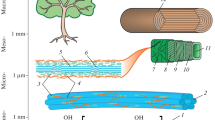Summary
The diamagnetic anisotropy and absolute susceptibilities of wood, lignin and wood cellulose have been determined. It has been found that the ‘crystalline’ element in wood is definitely cellulose and that lignin and the hemi-celluloses make no contribution to the magnetic anisotropy, suggesting either a random orientation if they are crystalline or an amorphous structure. In the light of evidence from other sources, it seems most likely that they are amorphous. The anisotropy measurements also indicate that the direction of maximum diamagnetic susceptibility in the cellulose molecule is along the length of the chain. Since it is also known that the direction of maximum electric polarisability too is along the chain length, we find that these directions coincide in the molecule just as in the case of the higher long-chain saturated hydrocarbons.
Similar content being viewed by others
References
P. Nilakantan,Proc. Ind. Acad. Sci., 1935,2A, 621; 1936,4A, 542.
A. W. Schorger,Chemistry of Cellulose and Wood, McGraw Hill Publishing Co., Ltd., 1926; Hawley and Wise,The Chemical Catalogue Co., 1926.
P. Nilakantan,Proc. Ind. Acad. Sci., 1937,5A, 166.
K. H. Meyer and H. Mark,Der Aufbau der Hochpolymeren Oraganischen Naturstoffe, Leizig, 1930; H. Mark and F. Schossberger,Ergeb. d. Exact. Naturwiss., 1937,16, 226; E. Sauter,Zeit. f. Phys. Chem., 1937,B35, 18–128.
H. Staudinger,Die Zellstoff Faser, 1936, 1, Nr. 11/12.
A. Frey-Wyssling,Protoplasma, 1936,25, 261; E. Sauter,loc. cit. Zeit. f. Phys. Chem., 1937,B35, 18–128; O. Kratky and H. Mark,Zeit. f. Phys. Chem., 1935,B36, 129.
Reinhardt Theissen,Ind. Eng. Chem., 1932,24, 1034; W. K. Farr,Jour. Appl. Phy., 1937,8, 230–31.
K. Freudenberg and W. Dürr,Handbuch d. Pflanzenanalyse, 3, Part II, 125 (Julius Springer, 1932).
H. Pringsheim and D. Krüger,ibid..
W. H. Dore,Ind. Eng. Chem., 1920,12, 264.
A. W. Schoger,loc. cit. Chemistry of Cellulose and Wood, McGraw Hill Publishing Co., Ltd., 1926, p. 540.
A. W. Schorger,ibid., Chemistry of Cellulose and Wood, McGraw Hill Publishing Co., Ltd., 1926, p. 524.
P. Nilakantan,Proc. Ind. Acad. Sci., 1936,4A, 542.
—,ibid.,, 1937,5A, 171.
A. Frey,Ambronn-Festschrift Kolloid Chem. Beih., 1927,23, 40; K. Kanamaru,Helv. Chim. Acta., 1934,17, 1047.
M. Ramanadham,Ind. Jour. Phys., 1929–30,4, 15; M. Scherer,Comptes Rendus, 1931,192, 1223.
Author information
Authors and Affiliations
Additional information
(Communicated by Sir C. V. Raman, Kt., F.R.S., N.L.)
Rights and permissions
About this article
Cite this article
Nilakantan, P. Magnetic anisotropy of naturally occurring substances. Proc. Indian Acad. Sci. (Math. Sci.) 7, 38–49 (1938). https://doi.org/10.1007/BF03045379
Received:
Issue Date:
DOI: https://doi.org/10.1007/BF03045379




